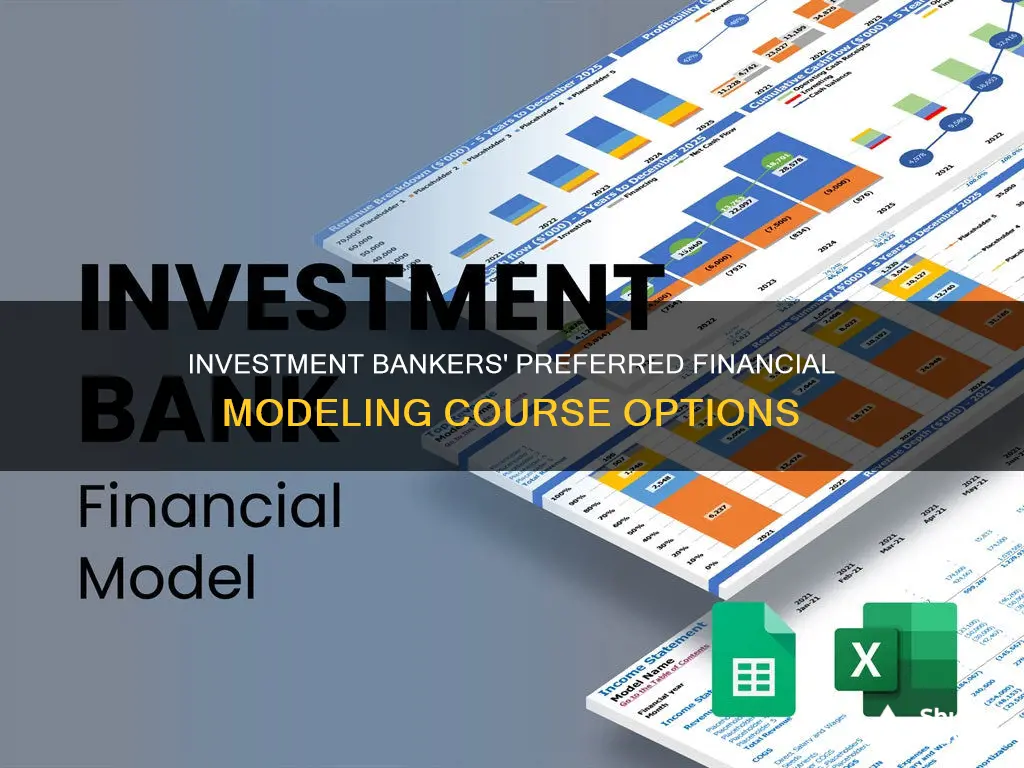
Financial modelling is a crucial skill for investment bankers, allowing them to project a company's financial performance and make informed decisions. Investment bankers use various financial models, including the One Page DCF model, Comps Model Template, Restructuring Model, and Leveraged Finance Model, to evaluate and make strategic choices. To meet the industry demand, several institutions offer financial modelling courses, with Wall Street Prep's Premium Package being a popular choice. This course equips individuals with the practical knowledge and skills needed to succeed in investment banking. It covers essential topics such as financial statement modelling, DCF analysis, M&A, and LBO modelling, providing a comprehensive understanding of financial modelling techniques.
What You'll Learn

Financial modelling courses for investment bankers
Financial modelling is an important skill for investment banking professionals to possess. Financial modelling courses are often sought out by those who want to establish themselves in investment banking careers, but they can also be helpful for those already working in the industry.
There are a variety of financial modelling courses for investment bankers available. Here is a list of some of the most popular and reputable options:
Wall Street Prep Premium Package
Wall Street Prep provides online training for those who work in the financial industry, including investment bankers. They offer two different financial modelling education packages: a basic package and a premium package. The premium package is designed to mimic the actual experience of a financial analyst and relies heavily on the presentation of real-world case studies. The course material is authored by senior investment bankers from firms such as JPMorgan Chase and Credit Suisse. The course covers basic financial statement modelling and teaches students how to construct financial statement projection models in Microsoft Excel, including sensitivity analysis and industry best practices.
Breaking Into Wall Street Premium Package
The Breaking Into Wall Street (BIWS) Premium course is created and taught by professionals. It covers similar material to the Wall Street Prep curriculum, including sections on DCF analysis, financial statement modelling, M&A, and comparables. The course relies heavily on video training and includes extensive practice exercises in using Excel, comparing different valuations, and examining actual case studies of M&A deals. The package also includes Excel and financial modelling fundamentals courses at no extra charge, and a financial and valuation modelling certification upon completion.
Wall Street Training Core Module Packages 2 to 6
The Wall Street Training program offers core module packages that cover financial evaluation and modelling. Package 2 offers instruction in basic evaluation and financial modelling, while Package 3 provides comprehensive advanced financial modelling. Package 4 covers corporate finance and valuation methodologies, and Package 5 focuses on M&A modelling. Package 6 covers financial modelling for leveraged buyouts. The modules can be purchased individually or as a package, with the option to save money by purchasing only the specific instruction needed.
Certified Financial Modeling & Valuation Analyst (FMVA) from CFI
The Certified Financial Modeling & Valuation Analyst (FMVA) course is offered by the Corporate Finance Institute and provides brand recognition and CV value. The curriculum is divided into a series of optional, required, and elective courses, allowing students to pick and choose based on their skill level and experience. The bulk of the electives are related to financial modelling and Excel, with foundational courses covering business valuation modelling, budgeting, forecasting, scenario analysis, and more. Advanced topics include sector-specific modelling, such as mining financial modelling, LBO modelling, and renewable energy modelling.
The Modeler Course from Financial Edge
Financial Edge is an elite training provider that offers in-house training to bankers at top investment banks. The Modeler Course from Financial Edge is well-designed and structured, with plenty of videos and practical exercises to build confidence. The course covers a range of topics, including an introduction to modelling, basic financial statement analysis, advanced modelling with three financial statements, Excel tricks, and more advanced topics such as cash sweeps, revolvers, circularities, and long-term debt.
Business and Financial Modelling from Wharton
This course from Wharton is suitable for beginners and provides a smooth learning curve to help students grasp financial modelling concepts. The course covers spreadsheet modelling, investment analysis, company valuation, forecasting, decision-making, and scenario analysis. It offers excellent value, with competitive pricing for the quality and range of modules delivered by top Wharton faculty.
Financial Modeling Professional Certificate from NYIF
The New York Institute of Finance's Financial Modeling Professional Certificate course is more advanced and meant for investment banking analysts, private equity, or hedge fund professionals. It provides hands-on guidance from industry experts in a virtual/physical classroom environment. The course begins with an advanced Excel course, followed by modelling, and then three full days spent on valuations.
These courses offer a range of options for those seeking to improve their financial modelling skills for investment banking, with a mix of online, on-demand, and classroom-based learning available.
VRDN Investment: Is It Worth the Risk?
You may want to see also

The importance of financial modelling in investment banking
Financial modelling is an indispensable tool for investment banking, which acts as a nexus between financial institutions and corporations. It is a process of creating a representation of a company's financial performance based on a set of assumptions about the future. Analysts use financial modelling to simulate various scenarios and make informed decisions.
Investment banking focuses on evaluating the worth of companies and creating capital for corporations, governments, and other institutional organisations. Financial modelling is an important skill for investment banking professionals as it helps them determine the value of a company, investment, or financial asset. It is used to calculate the impact of different variables, such as interest rates or corporate growth rates, on the value of an asset.
Financial modelling is particularly useful in the following key areas of investment banking:
- Valuation: Financial modelling helps determine the intrinsic worth of a business during acquisitions or buyouts.
- Mergers & Acquisitions (M&A): Financial models assess the financial impact of a potential merger and how much one company should pay for another.
- Project Finance & Advisory: For large-scale infrastructure projects, financial modelling evaluates feasibility, expected returns, and associated risks.
- IPOs: When a company goes public, financial models provide the groundwork for its valuation.
Financial modelling offers several benefits, including informed decision-making, risk management, and efficiency. By simulating multiple scenarios, banks can understand the implications of different strategies and proactively mitigate risks. With a robust model, banks can also quickly adapt to new information, leading to agile decision-making.
However, it is important to remember that financial models are built on assumptions, which may sometimes be erroneous or fail to account for unexpected market shifts. As such, understanding the limitations of the model and using it as a guide rather than an absolute predictor is crucial.
Smart Ways to Invest a Windfall of $300K
You may want to see also

The scope of a financial modelling course
Financial modelling is a tool that helps companies with planning and decision-making. It is used to create a historical, current, or projected value of a company, investment, or financial asset. Financial modelling courses are often sought out by those who want to work in investment banking, but they can also be useful for those already working in the industry.
Financial modelling courses teach students how to create a mathematical model that reflects the financial performance of a company. This involves using software like Microsoft Excel to perform calculations and build models. The courses cover various types of financial models, such as three-statement models, discounted cash flow models, and merger models.
The courses also teach students how to assess future operational plans, estimate future financial performance, and analyse data. Additionally, students learn how to link three financial statements: the income sheet, balance sheet, and cash flow sheet.
Financial modelling courses can lead to career opportunities in investment banking, management consultancy, equity research, private equity, and corporate finance. The skills learned in these courses are highly valued by employers and can lead to high-paying salaries.
The eligibility criteria for financial modelling courses vary, but generally, candidates must have a strong background in finance, accounting, mathematics, or a related field. The courses are designed to provide students with the latest relevant knowledge and help them develop their analytical, valuation, and estimation skills.
Overall, financial modelling courses offer a comprehensive understanding of financial modelling and its applications, providing students with the skills and knowledge to succeed in a variety of finance careers.
Edward Jones: Benefits of Using Their Investment Services
You may want to see also

How financial modelling can help your career in investment banking
Financial modelling is an important skill for investment banking professionals to possess. It can be used to predict trends and advise companies on decision-making criteria, supporting good investment decisions. Financial modelling can help your career in investment banking in several ways:
Building a Forecast
Financial models help businesses build a credible forecast and design budgets based on historical data and trends. By aligning their budgets with the forecast, businesses can continue their activities in a structured manner.
Enhancing Understanding of the Business
Financial models provide a deeper insight into the financial position of a business. They show how a business is operating, where its focus should be, and what factors are affecting the business. This includes both internal and external elements.
Planning Fund Requirements
A financial model provides information on cash inflow and outflow, helping businesses understand their income sources and net cash flows needed to keep their operations running. To ensure smooth operations, a business must arrange funding through debt or equity, and a financial model will give a clearer picture of cash flow after setting off loan repayment and interest.
Minimising Risk
Financial models help businesses reduce risk by scrutinising the financial impact of any activity. For example, if a business plans to invest in another company or enter a new market, the financial model can guide the risk, costs, and market trends.
Achieving Business Growth
Financial models can point businesses in the direction of growth by helping them make financial decisions and deterring them from taking unnecessary risks. Accurate financial models can also help businesses increase profitability through cost-benefit analyses of projects.
Overall, financial modelling is a highly valuable skill for investment bankers, enabling them to make informed decisions, minimise risk, and drive business growth.
Fidelity Investments: A Guide to Getting Started
You may want to see also

Where to learn financial modelling
Financial modelling is an important skill for investment banking professionals to possess. Investment banking analysts use financial modelling to evaluate the worth of companies and create capital for corporations, governments, and other organisations.
There are several options for learning financial modelling, including online courses, business school courses, and boot camps. Here are some places where you can learn financial modelling:
Wall Street Prep Premium Package
The Wall Street Prep Premium Package is designed to mimic the actual experience of a financial analyst. The course is authored by senior investment bankers from firms like JPMorgan Chase and Credit Suisse. It covers basic financial statement modelling, teaching students how to construct financial statement projection models in Microsoft Excel. The course also includes modules on DCF analysis, M&A, and leveraged buyouts (LBOs). The course is used for in-house training at prestigious investment banks and offers an official certification in financial and valuation modelling.
Breaking Into Wall Street Premium Package
The Breaking Into Wall Street (BIWS) Premium course covers similar material to the Wall Street Prep Premium package, including DCF analysis, financial statement modelling, M&A, and comparables. The course uses video training and includes practice exercises in Excel. The BIWS course also provides a financial and valuation modelling certification.
Wall Street Training Core Module Packages
The Wall Street Training program offers core module packages that cover financial evaluation and modelling. Package 3 provides advanced financial modelling instruction, teaching students how to prepare an integrated five-year financial statement model. Package 5 focuses on M&A modelling, while Package 6 covers financial modelling for leveraged buyouts. Individuals can also purchase individual courses or an Excel training module.
Certified Financial Modeling & Valuation Analyst (FMVA) from CFI
The Certified Financial Modeling & Valuation Analyst (FMVA) course is offered by the Corporate Finance Institute. It has a modular structure, allowing students to pick and choose courses based on their skill level and experience. The curriculum covers financial modelling, Excel, business valuation modelling, budgeting, forecasting, and sector-specific modelling. The course includes case studies and is designed by bankers with industry experience.
The Modeler Course from Financial Edge
Financial Edge is an elite training provider that offers in-house training to bankers at top investment banks. The Modeler Course covers basic modelling concepts, advanced modelling with three financial statements, and Excel tricks for model preparation. The course includes over 50 practical exercises and provides a certification upon completion.
Business and Financial Modeling from Wharton
The Business and Financial Modeling course from Wharton is suitable for beginners and covers spreadsheet modelling, investment analysis, company valuation, forecasting, and scenario analysis. The course is delivered by top Wharton faculty and provides a completion certificate.
Financial Modeling Professional Certificate from NYIF
The New York Institute of Finance (NYIF) offers a Financial Modeling Professional Certificate course that is meant for investment banking analysts, private equity, or hedge fund professionals. The course includes an advanced Excel course, modelling instruction, and valuations. NYIF has been teaching bankers and traders for almost a century.
Additional Options
Other options for learning financial modelling include the Financial Modelling and Analysis course from the University of Cape Town, Udemy's smaller focused courses, and Excel and VBA Programming for Finance from NYIF.
Spend, Save, Give, Invest: Jars for Financial Freedom
You may want to see also
Frequently asked questions
The scope of a financial modelling course is huge, as financial models are used extensively across industries. They are used to aid in important decision-making processes, analyse sensitivity, explore returns on investments, assess and limit risk, and perform scenario analysis.
Investment bankers use several types of financial models, including the One Page DCF model, Comps Model Template, Restructuring Model, and Leveraged Finance Model.
You can learn financial modelling from institutions like IMS Proschool, which provides a comprehensive program on financial modelling, including basic and advanced modules.







